CORRECT ESTABLISHMENT IS VITAL TO GET THE BEST FROM SPRING-SOWN CROPS
Spring crops have become an increasingly important component in many arable rotations, but to deliver best performance they must be established correctly, writes Jeff Claydon, who farms in Suffolk and designed the Claydon OptiTill® System
In the last issue of Direct Driller magazine, I highlighted the importance of effective stubble management in producing excellent crops and outlined how to achieve it. This time I want to look at how we deal with spring crops, of which we have 65ha this year, comprising 16ha of beans and 49ha of oats. According to the meteorological calendar, spring starts on 1 March while the astrological spring begins on 20 March but whichever measure you go by farming at a high level involves so much more than simply working to a date in the diary. Having an innate feel for everything that is happening around you and working in harmony with Mother Nature are much more important. The need for this has been illustrated quite graphically in recent years.

The winter of 2017-2018 was long, cold, wet and seemed to go on forever. The weather was anything but spring-like right through until the end of April, then we had four months of severe drought. Conditions this year, at least up to the time of writing on 21 February, have been the exact opposite, with winter almost non-existent and soil temperatures already at 7°C. The contrast could not be more marked. Drilling spring crops started very early on the Claydon farm, with spring beans sown directly into over-wintered tilth with no need for a prior application of glyphosate on 29 January following over-night frost when the temperature dropped to -5°C. Soil conditions were excellent, better in fact than when we drilled winter beans in October, which just goes to show that you must take an opportunity when it presents itself. One of the hallmarks of a good farmer is that they constantly watch for the many signals which nature provides and work accordingly. This is particularly important when the countryside wakes up in the spring.
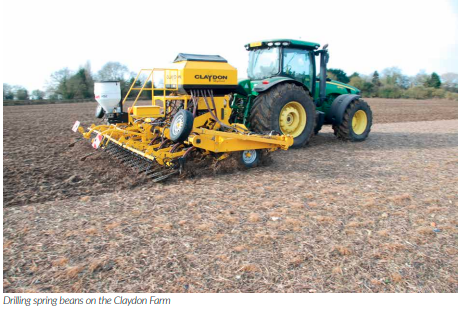
Wide window of opportunity
The big advantage of the Claydon Opti-Till® System which we operate is that our soils become better every year and are in excellent condition, their very high resilience and carrying capacity providing a wide window of opportunity in which to carry out field work. Crops are established in just onefifth of the time of a traditional ploughbased system and in one-third of the time needed for min-till, which means that it is much more flexible and allows us to wait until conditions are exactly right for the soils and crops rather than having to muddle them in.
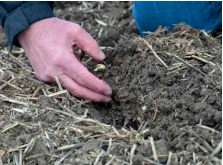
This way of working also greatly reduces the weather risk compared with a conventional system. The latter involves a sequence of cultivation operations that creates an unstructured soil profile with limited weight-bearing capability and an increased likelihood of sedimentation; this causes the soil to slump and become anaerobic. For example, had we ploughed the land destined for spring beans during the autumn and left it over winter, it would have laid wet at the end of January and no way could we have drilled the crop when we did. That would have had a substantial, adverse knock-on effect because we would have had to spend substantially more on ag-chems.
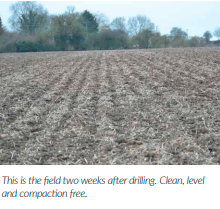
In the autumn we carried out a comprehensive stubble management programme which included several passes with the 15m straw harrow to encourage multiple flushes of volunteers and weeds, then killed off any remaining green material with a single application of glyphosate in November. This left the fields clean but with a shallow layer of surface tilth which provided ideal conditions over the winter and going into spring.
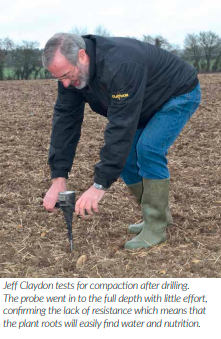
We were able to drill directly into this perfect growing environment because of the preparation work which had started back in the autumn using a combination of mechanical and chemical methods. With fewer herbicides now available, and remaining actives becoming more expensive and less reliable, it is vital to supplement them with mechanical methods, such as the straw harrow, to enhance the overall effectiveness of weed control. The other important advantage of this approach is that it creates 25mm to 30mm of tilth which retains moisture, allows the soil to breathe, makes it easier for worms to process the chopped straw and eventually covers the seed.
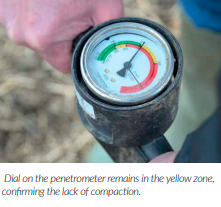
Pre-drilling routine
Before drilling, I always look at the weather forecast to check for three or four days of dry weather afterwards, because the last thing we want is heavy rain falling on freshly-drilled land. This would cause the surface of our heavy clay to cap, preventing air/water from penetrating and hindering the young seedlings’ emergence, at best stunting their development and perhaps even preventing them from doing so. Even if you get everything right in terms of preparing fields in the autumn there is no guarantee that when you leave them over winter they will still be ‘right’ in the spring so, before any crop goes in the ground, I carry out several checks to ensure that we are good to go with the drill.
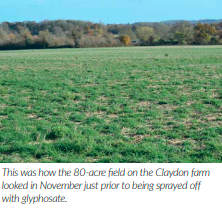
I look to see how many earthworm casts are present on the surface, because this is one of the easiest, quickest and best indicators of good soil health. There’s nothing better than seeing clusters of worm casts and finding plenty of worms in the soil profile, because the entire process of farming depends on them. The passages they create in the soil promote air exchange and drainage, so without these essential little creatures you will never come even close to maximising the potential of your soils or crops. Before drilling any field, I always dig into the soil to check its condition. Healthy soil should be dry, but not too dry, friable so that it crumbles easily between your fingers and have a lovely ‘fresh’ smell which indicates that plenty of air is present.
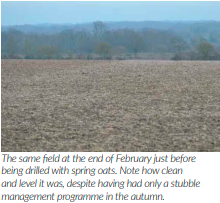
In contrast, anaerobic soil will be lifeless, sticky, clump together and smell stale because it cannot breathe and therefore contains very little oxygen. If that is the case, you need to re-consider how you are farming. Part of this might be to change your system. When assessing soil condition prior to drilling I also carry out several penetrometer tests across the field to check that there are no soil pans. If there are you feel them immediately because the probe becomes much more difficult to push into the ground and the needle on the dial swings into the red zone. Pans are not caused solely by compaction from heavy machinery or working when conditions are unfavourable but can result from the sedimentation of soils that have been over-cultivated and ‘settled out’ over the winter.
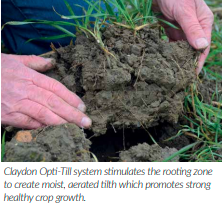
Because we drilled spring beans so early this year, we deliberately sowed them quite deep, 70mm to 80mm, so that they would take time to emerge, allowing early-germinating weeds to be taken out cheaply and effectively with one application of glyphosate before the crop came through. Evidence of good soil structure could clearly be seen when drilling the crop, because the tyres on our 330hp John Deere 8345R ran clean in the frosthardened soil and left barely a mark on the surface, even when turning on the headlands with the 6m Claydon Hybrid mounted drill raised. Even in the tyre tracks the penetrometer reading remained well within acceptable limits. Last year, when the beans were at the ‘rosette’ stage we went over the field with a harrow to take out any emerging weeds, even though most were barely visible. This operation left the beans untouched, prevented weeds from developing, maintained a shallow tilth to retain moisture and helped the crop get off to a good start. It would also prevent the soil from capping in the event of heavy rain and baking hard when it dried out.
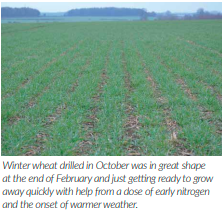
Since we started direct seeding 16 years ago, removing compaction is not something we have had to do because it has never been an issue. The soil has become so resilient that it has enormous carrying capacity and will easily support the weight of following operations. Our 5000-litre Knight selfpropelled sprayer weighs 18 tonnes, but it is used to apply nitrogen early in the season and that means crops get off to a flying start as soon as the weather turns warmer. The benefits of a resilient soil structure are evident throughout the farming year and, because it virtually eliminates machinery from sinking into the soil, the surface remains level, crops emerge unhindered, while field operations can be carried out faster, more accurately, more comfortably with less likelihood of damaging machinery. There is no downside and I will talk more about this in the next issue.
Fine-tuning production is essential
Whatever your views on Brexit, whether for or against, this prolonged process has demonstrated quite clearly that as farmers we must become even more efficient and self-sufficient. Farming is a very traditional industry and despite evidence to the contrary, many involved remain stuck in ‘The Cultivation Trap’, using traditional techniques and machinery which are time consuming, expensive, damage the soil, use large amounts of diesel and release large quantities of soil organic carbon. The key question we all must now ask is ‘how am I going to reduce my production costs to a base level which will enable me to compete in a global market, yet continue to operate a financially and agronomically viable farming business? With seed, ag-chems and fertilisers offering only limited scope for savings the focus must be on cutting establishment and machinery costs. There are many ways to do so, but critically it must be done without compromising yields and output, which means having a low-cost system which is reliable and repeatable.

Some farmers will continue as they have regardless, others will use some form of min-till to establish crops, but move a lot of soil and incur excessive costs in the process, while others will simply cut seed into the ground using a zero-till drill, but the UK’s maritime climate means that presents a huge risk and is like playing Russian Roulette with the future of your farm.
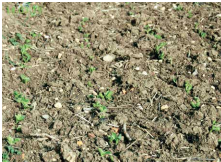
Done correctly, direct seeding using the Opti-Till® System provides a thoroughly tried and tested method which will improve timeliness, reduce weather risk, produce more even and reliable establishment, increase yield potential, provide higher returns and much greater profitability. It also generates a raft of environmental and wildlife related benefits, including increased soil organic matter, reduced risk of erosion, increased carbon sequestration and more soil fauna. Where businesses are struggling to be profitable, they must review what they are doing currently, question whether and how they can do the job better, consider how to produce more for less and realistically assess the risks of carrying on as they are compared with the potential rewards of adopting a new approach. Some might argue that spending money on a new system is not the right thing to do at the current time, but I would argue that exactly the opposite is true. The key is to invest wisely, in a system which will save you money, generate increased returns and ensure that your business remains viable in the future.
To learn more about the Claydon Opti-Till® System and techniques to improve your farm’s performance contact your local Claydon dealer and arrange a visit to the Claydon farm.

